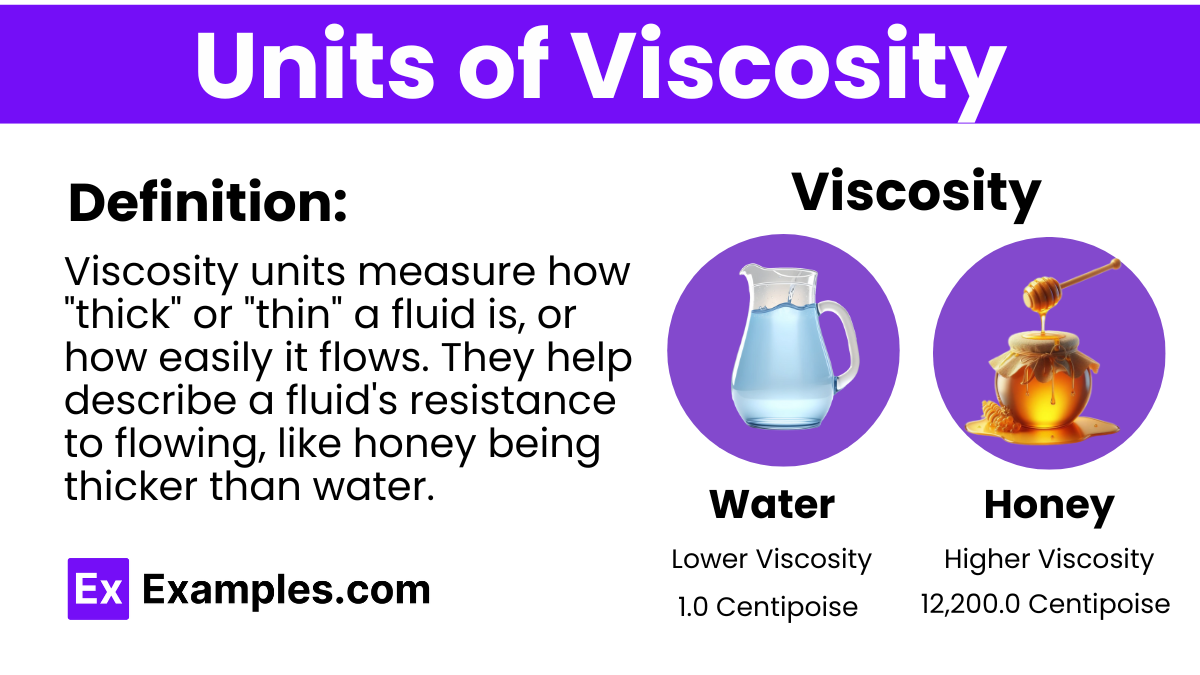What is the SI unit of dynamic viscosity?
Pascal
Newton
Poise
Pascal-second

What is the Unit of Viscosity?
The unit of viscosity is the pascal-second (Pa·s) in the International System of Units (SI). Viscosity refers to the resistance of a fluid to flow, and it is a crucial property in fluid dynamics.
Viscosity (η) can be defined by the relationship between the shear stress (τ) and the shear rate (γ˙) with in a fluid, expressed by Newton’s law of viscosity:
Where:
τ is the shear stress, measured in pascals (Pa).
η is the dynamic viscosity, measured in pascal-seconds (Pa·s).
γ˙ is the shear rate, measured in reciprocal seconds (s⁻¹).
The SI unit of viscosity is the pascal-second (Pa·s), also commonly expressed as the kilogram per meter per second (kg/(m·s)). Viscosity is a measure of a fluid’s resistance to flow. It describes the internal friction within a fluid as it flows.
Viscosity is often denoted by the symbol η (eta). It can be calculated using the formula:
Where:
η (eta) is the viscosity (in pascal-seconds, Pa·s)
F is the force (in newtons, N) applied perpendicular to the direction of flow
d is the distance (in meters, m) the fluid layer moves in the direction of the force
A is the area (in square meters, m²) through which the force is applied
v is the velocity (in meters per second, m/s) of the fluid
In the CGS (centimeter-gram-second) system, the unit of viscosity is the poise (P). Viscosity measures a fluid’s resistance to flow, with higher viscosity indicating greater resistance. The formula to calculate viscosity in CGS units is:
Where:
Force is measured in dynes (dyn), which is the CGS unit of force.
Area is measured in square centimeters (cm²).
Velocity is measured in centimeters per second (cm/s).
| Unit | Symbol | Description |
|---|---|---|
| Pascal-second | Pa·s | SI unit, measures dynamic viscosity. |
| Kilogram per meter per second | kg/(m·s) | Common unit, often used for kinematic viscosity. |
| Newton-second per square meter | N·s/m² | Equivalent to pascal-second (Pa·s). |
| Poise | P | CGS unit, equivalent to 0.1 Pa·s. |
| Centipoise | cP | Submultiple of poise, commonly used in industry. |
| Pound-force second per square inch | lbf·s/in² | Common unit in engineering applications. |

| Viscosity Conversion | Conversion Factor |
|---|---|
| Poise to Pascal-seconds (Pa·s) | 1 Poise (P) = 0.1 Pa·s |
| Pascal-seconds to Poise | 1 Pa·s = 10 Poise |
| Centipoise to Pascal-seconds | 1 Centipoise (cP) = 0.001 Pa·s |
| Pascal-seconds to Centipoise | 1 Pa·s = 1000 Centipoise |
| Poise to Centipoise | 1 Poise = 100 Centipoise |
| Centipoise to Poise | 1 Centipoise = 0.01 Poise |
One poise (P) is equivalent to 0.1 pascal-seconds (Pa·s), serving as a conversion factor between viscosity units in the CGS and SI systems.
One pascal-second (Pa·s) corresponds to 10 poise (P), facilitating the conversion of viscosity measurements from the SI system to the CGS system.
One centipoise (cP) is equal to 0.001 pascal-seconds (Pa·s), providing a conversion factor for viscosity measurements between smaller units in the SI system.
One pascal-second (Pa·s) corresponds to 1000 centipoise (cP), facilitating viscosity conversions from the SI system to smaller units.
One poise (P) equals 100 centipoise (cP), facilitating viscosity conversions between CGS and SI units, particularly for larger values in the centipoise scale.
One centipoise (cP) is equal to 0.01 poise (p). This conversion factor simplifies transitioning between centipoise and poise, commonly used in measuring viscosity of fluids.
Viscosity is crucial in various fields such as engineering, physics, and chemistry. It affects the behavior of fluids in processes like flow, mixing, and lubrication.
Viscosity is typically measured using viscometers, instruments designed to determine the resistance of a fluid to flow under specific conditions.
Viscosity is applied in various industries, including automotive (engine oils), food and beverage (sauces and syrups), pharmaceutical (drug formulations), and petroleum (drilling fluids).
Yes, viscosity can change with time due to factors such as temperature variations, chemical reactions, and the aging of fluids. This phenomenon is known as viscosity variation or rheological behavior.
Text prompt
Add Tone
10 Examples of Public speaking
20 Examples of Gas lighting
What is the SI unit of dynamic viscosity?
Pascal
Newton
Poise
Pascal-second
Which unit is commonly used to measure viscosity in the CGS system?
Poise
Newton
Poise
Pascal-second
What is the relationship between the poise and the Pascal-second?
1 Pa·s = 10 P
1 Pa·s = 0.1 P
1 Pa·s = 0.1 P
1 Pa·s = 0.01 P
If a fluid has a viscosity of 0.5 Pa·s, what is its viscosity in poise?
0.5 P
5 P
50 P
500 P
Which of the following units is NOT used to measure viscosity?
Poise
Centipoise
Pascal
Pascal-second
Which unit is larger, the poise or the centipoise?
Poise
Centipoise
They are the same
It depends on the context
What is the viscosity in centipoise (cP) if a fluid has a viscosity of 0.02 Pa·s?
2 cP
20 cP
200 cP
2000 cP
Which of the following statements is true about viscosity?
Viscosity is a measure of a fluid's density
Viscosity is a measure of a fluid's resistance to flow
Viscosity is the same as surface tension
Viscosity is independent of temperature
What is the unit of kinematic viscosity in the CGS system?
Stokes
Poise
Pascal-second
Centipoise
How is the dynamic viscosity of a fluid affected by increasing temperature, generally?
It increases
It decreases
It remains constant
It first increases then decreases
Before you leave, take our quick quiz to enhance your learning!

